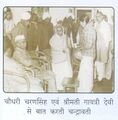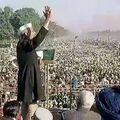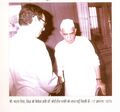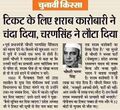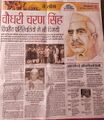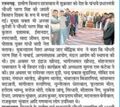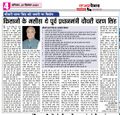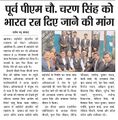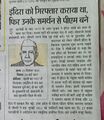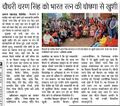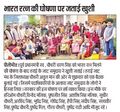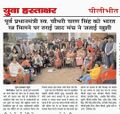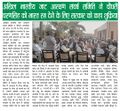Chaudhary Charan Singh
| Author: Laxman Burdak, IFS (R) |
For article in Hindi see चौधरी चरणसिंह
Chaudhary Charan Singh
| Full Name | Chaudhary Charan Singh |
|---|---|
| Born | 23 December 1902 Died : 29 May 1987 |
| Residence | Noorpur in western Uttar Pradesh |
| Nationality | |
| Occupation | Fifth Prime Minister of the Republic of India, 3rd Deputy Prime Minister of India, Chief Minister of Uttar Pradesh (3 April 1967 – 25 February 1968) |
| Parent(s) | Chaudhary Meer Singh (Father), Smt. Netrakaur (Mother) |
| Gotra | Tewatia |
- Political party : Janata Party (Secular) (1979–1987)
- In 1929 he joined the Indian National Congress
Chaudhary Charan Singh (Tewatia) (b. 23 December 1902 - d. 29 May 1987) was the fifth Prime Minister of the Republic of India from 28 July 1979 to 14 January 1980. On 9 February 2024 Chaudhary Charan Singh was awarded Bharat Ratna, the highest civilian award of the Republic of India.
Early life
Chaudhary Charan Singh was from Noorpur Ki Madhaiya in western Uttar Pradesh born in Tewatia clan Jat family. Like Sir Chhotu Ram, he came from a rural, peasant family and went on to become a lawyer. His father Mir Singh was a tenant-peasant of 5 acres in Noorpur. Thus Charan Singh was born into a poor, small tenant peasant family, not a landlord at all. Both of them promoted the concept of a united rural community, encompassing not only the Jats, but others as well. And both of them shared a common concern about the exploitative nature of the brahman-bania combine in those days.
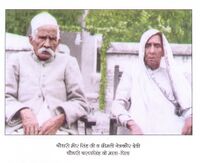
Charan Singh's ancestors were the kinsmen of prominent freedom-fighter of the revolt of 1857, Raja Nahar Singh of Ballabhgarh (in present day Haryana). Raja Nahar Singh was sent to the gallows in Chandni Chowk of Delhi. Raja Nahar Singh was hung by the British at Delhi’s Chandni Chowk in 1857 for his revolutionary role in India’s First War of Independence. In order to escape the oppression the British Government let loose on Raja's kinsmen and supporters, Charan Singh's grandfather moved to district Bulandshaher in Uttar Pradesh.[1]
Family Members
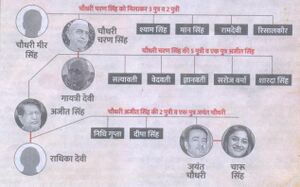
- Chaudhary Charan Singh
- Father Chaudhary Mir Singh Tewatiya of village Noorpur Ki Madhaiya.
- Mother Netra Kaur of village Chitsona Alipur of Bulandshahr.
- Wife Mp & MLA Gayatri Devi, daughter of Chaudhary Ganga Ram Jatrana (Arya) of Garhi-Kundal in Sonipat Haryana
- Four daughters and Son-in-laws
- Satya Vati married MLA Prof. Gurudutt Solanki descendent of Raja Kanhi Singh Solanki Kagarol of Kagarol Riyasat Agra Uttar Pradesh
- Ved Vati married Dr. Jai Pal Singh Luhach (Lohit) (Padamshree) of Bhadangpur Hapur Uttar Pradesh - son Harsh Singh Lohit
- Dr. Gyanwati Singh Tomar (nee Tewatiya) married to IPS Satyendra Tomar (DGP of Maharashtra) from Hajipur Bijnor Uttar Pradesh
- Sharda married Basudeva Singh of Shadipur Milak in Bijnor Uttar Pradesh
- MLA Saroj Verma (Tewatiya) married Avinash Verma
- son MP, MLA & Union Minister Ajit Singh married Radhika Bishnoi, daughter of Kunwar Sukhbir Singh Bishnoi Jagir Fatehpur Bisnoi in Kanth tehsil of Moradabad Uttar Pradesh
- Grandson MP, MLA & Minister Jayant Chaudhary
- https://www.charansingh.org/ccs-family
Ancestors
Education
Charan Singh was born on 23 December 1902 in town Noorpur, district Bulandshahr then, and now Ghaziabad of Uttar Pradesh in a peasant's home. He was a good student, and obtained degree of Masters in Arts in 1925, and the degree of Law in 1927.
He obtained Primary school education at Jani Khurd village, Matriculation from Meerut (1919), and Intermediate Degree from Agra College (1921).
He obtained Bachelor of Science from Agra College (1923), Master of Arts in History from Agra College (1925) in Europe, England and Indian history, Master in Law from Meerut College, Meerut (1927)
Career in Politics
Born in a Jat family in 1902[2][3], Charan Singh entered politics as part of the Independence Movement. After independence he became particularly notable in the 1950s for opposing and winning a battle against Nehru's socialistic and collectivist land use policies, for the sake of the Indian farmer. He was very popular among all the rural and farming communities, his political base was Western Uttar Pradesh and Haryana.
In 1929 he joined the Indian National Congress. He was jailed several times in the struggle for Indian independence. He served in the United Provinces (now Uttar Pradesh) state assembly from 1937 on.
In February 1937 he was elected to the Legislative Assembly of Uttar Pradesh (United Provinces) at the age of 34. In 1938 he introduced an Agricultural Produce Market Bill in the Assembly which was published in the issues of The Hindustan Times of Delhi dated 31 March 1938. The Bill was intended to safeguard the interests of the farmers against the rapacity of the traders. The Bill was adopted by most of the States in India, Punjab being the first state to do so in 1940. Thus His political career began through the Congress ranks, supporting tenant rights. Working against the vein of early Congress policy and fighting formidable landlord influence, he mobilised support for peasant ownership of land, implemented reforms, and prevented tax increases on farmers. He worked to make farmers into an aggressive political force.
Charan Singh followed Mahatma Gandhi in non-violent struggle for independence from the British Government, and was imprisoned several times. In 1930 he was sent to jail for 6 months by the British for contravention of Salt laws. He was jailed again for one year in November 1940 for individual Satyagraha Movement. In August 1942 he was jailed again by the British under DIR and released in November 1943. Along with Mahatma Gandhi he was also influenced by Swami Dayanand, Kabir
and Sardar Patel.
Prof. Paul R. Brass writes that "Charan Singh was a phenomenon who arrived on the national stage in peasant costume and demeanor, but with the intelligence of an intellectual and a scholar. Those American and European Scholars who did meet him in the 1960s when he was a minister in the U P government - or out of the power temporarily - were immediately impressed by his intelligence, intellect, knowledge and demeanor."[4]
Election History of Chaudhary Charan Singh
Independent India
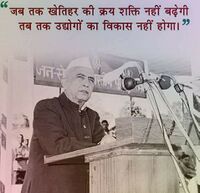
In 1952, he became the Revenue Minister of the state of Uttar Pradesh, the most populous state in independent India. He was dedicated to enforcing and implementing the provisions of the Zamindari Abolition and Land Reform Act of which he was the major architect. It has been argued by leading political scientists that success of Indian Democracy lies in successful implementation of this reform. Pakistan on the other hand did not have similar reforms, and the power is concentrated amongst the few powerful landlords or Zamindar who run their lands as their private fiefdom, and use their influence to further their wealth.
Charan Singh opposed Nehru on his Soviet style economic reforms. Charan Singh was of the opinion that cooperative farms would not succeed in India. Being a son of a farmer, Charan Singh opined that the right of ownership was important to the farmer in remaining a cultivator. Charan Singh's political career suffered due to his open criticism of Nehru's economic policy. In 1950's, no one questioned Nehru in India.
Chaudhary Charan Singh became an architect of India's national system of agrarian alliances. He brought about the Jat-Muslim political alliance in late 1960s when he was the Chief Minister of UP. He became the chief minister of the state in 67-68 and again in 70.
Charan Singh left the Congress party in 1967, and formed his own political party. He had two short stints as Chief Minister of Uttar Pradesh in 1967, and later in 1970. In 1975, he was jailed again, but this time by then Indian Prime Minister Indira Gandhi. She had declared the state of 'Internal Emergency' and jailed all her political opponents. After the Emergency was lifted and the elections for Lok Sabha were held, the Indian people voted her out; and the Janta Party, of which Chaudhary Charan Singh was a senior leader, came into power.
He remained committed to the ideal of a homogeneous and inclusive rural people. He was a product of Jat cultural assertion and the Arya Samaj movement and hence did not use caste as a rallying point. According to him, the Jat interests lay with the interests of the rural population.

In 1977, he allied his peasant and agricultural based Indian Revolutionary Party with the Janata Party of Morarji Desai and served as Home Minister (1977-78) and Deputy Prime Minister (1979) in Desai's coalition government. In July 1979 he became the Prime Minister of India with Congress support. But he resigned shortly afterwards, without facing a trust vote, when Indira Gandhi withdrew support. His speech to the nation on India's Independence Day (August 15, 1979 ) was very prophetic in which he identified Pakistan's nuclear ambition as a major threat to India. He also mentioned that Indian labour laws had to be refined if India were to become competitive in world economy. He also opened high level diplomatic relations with Israel, which Indira Gandhi's government which took office following the 1980 elections, curtailed.
It must be remembered that he was the first peasant leader (and the first Jat) to achieve that position. It was not until 1989, when Chaudhary Devi Lal became the Deputy PM, that any other Jat occupied such a high position and played such a significant role in national politics as he did. Though he was seen by the Jats of western U.P. as their sole benefactor, yet it would be unfair to call him merely a Jat leader. He could be described as a rural leader, whose support base transcended all rural communities.
Chaudhary Charan Singh passed away on May 29, 1987 in Delhi and was cremated at Kisan Ghat Delhi. He was survived by his wife, Gayatri Devi, four daughters (Satya, Vedvati, Gyanvati, Sharda) and one son, Ajit Singh.
Charan Singh Portrait in Rajyasabha
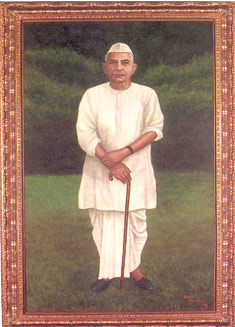
An ardent patriot, an able administrator, an astute statesman, a champion for the cause of India's peasantry, Chaudhary Charan Singh was a man of impeccable character and integrity and humanist inclinations. A long standing member of the Uttar Pradesh Legislative Assembly, he went on to become the Chief Minister of the State. He was Deputy Prime Minister in the Janata Party Government. A founder of the Bharatiya Kranti Dal and the Lok Dal, he ceaselessly strived for the amelioration of the lot of the peasants and weaker sections. As Prime Minister, he endeavoured to usher in various measures for the welfare of the common man.
The portrait, painted by Zeba Amrohawi, was unveiled by the then President of India, Dr. Shanker Dayal Sharma on 23 December 1993.
The portrait was donated by the Chaudhary Charan Singh Smarak Samiti.
National Farmers’ Day (Kisan Diwas)
National Farmers Day or Kisan Diwas is celebrated in the honor of Chaudhary Charan Singh who was the fifth Prime Minister of India. He was a very simple-minded man and led an extremely simple life. During his tenure as the Prime Minister, he introduced many policies to improve the life of Indian farmers. The magnetic personality of Chaudhary Charan Singh and various beneficial policies in the favor of farmers united all the farmers of India against the landlords and moneylenders. He followed the famous slogan ‘Jai Jawan Jai Kisan’ given by the 2nd Prime Minister of India. Chaudhary Charan Singh was also a very successful writer and wrote down several books depicting his thoughts on farmers and their problems; he even came out with various solutions to improve the lives of farmers. India is primarily the land of villages and majority of the population living in villages are farmers and agriculture is the main source of income for them. The green revolution during the 60s evolved in Punjab and Haryana transformed the agricultural picture of the country.This increased the productivity and thus India became self-sufficient in various agro-commodities.Farmers are the spine of India. The nation of lands, India celebrates Nationals Farmer’s Day every year on 23rd of December to pay honor to the great work done by the farmers of our country. The famous “Kisan Ghat” in New Delhi is dedicated to Chaudhary Charan Singh due to his involvement with the causes related to farmer’s communities in the North. [5]
Postal stamp on Charan Singh
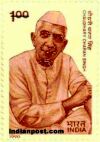
Indian Postal Department issued a commemorative stamp on him on 29/05/1990 of Denomination Rs.1.00.[6]
Bharat Ratna 2024
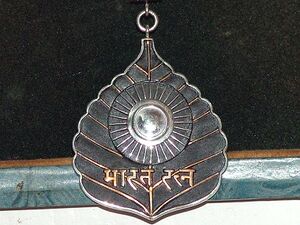
Read Bharat Ratna 2024 Investiture Ceremony Citation
सत्यमेव जयते
Bharat Ratna Award-2024
Investiture Ceremony
Rashtrapati Bhawan, Durbar Hall
March 30, 2024
'Bharat Ratna', the highest civilian award of the country, is awarded for exceptional service /performance of the highest order in any field of human endeavour.
Bharat Ratna
Chaudhary Charan Singh (Posthumous)
1. Chaudhary Charan Singh was a multi-faceted personality and an ardent patriot, an able administrator, an astute statesman and above all, a man of character, integrity and humanist inclinations.
2. Born on 23 December 1902 in a peasant family at Noorpur Village in Meerut District of United Province (Uttar Pradesh), Chaudhary Charan Singh had his primary education in the nearby village school at Jani Khurd and matriculation from Meerut. He graduated in Science in 1923 and secured his Master's degree from Agra College, Agra. He qualified for law degree in 1926 from Meerut College, Meerut.
3. Chaudhary Charan Singh was a founder member of the Ghaziabad Town Congress Committee from 1929 to 1939. He shifted to Meerut in 1939 and served as Treasurer, General Secretary and President of the Meerut District Congress Committee from 1939 to 1946. He was greatly influenced by the teachings of Mahatma Gandhi and Maharishi Daya Nand. At the call of Mahatma Gandhi, he joined the freedom struggle and was sentenced to jail three times - in 1930, 1940 and 1942 respectively.
4. Chaudhary Charan Singh was elected for the first time to the Legislative Assembly of the United Province from Ghaziabad-Baghpat constituency in Meerut District in 1937. He continued to be a legislator till 1977. He played a pivotal role in the eradication of the Zamindari System in Uttar Pradesh. Between 1951 and 1967, except for a short period, he functioned as a member of the State Council of Ministers holding important portfolios.
5.After the 1967 general elections, Chaudhary Charan Singh accompanied by 16 of his followers, quit the Congress and set up a group called the Jan Congress. Later, the entire opposition came together to form the Samyukta Vidhayak Dal (SVD). As a leader of SVD, Chaudhary Charan Singh was appointed as the Chief Minister of Uttar Pradesh on 3rd April 1967. Inner strains and squabbles led to the downfall of the SVD Government and the State was placed under President's rule. In the course of subsequent turn of events in the Assembly, he once again became the Chief Minister in February 1970.
6.Chaudhary Charan Singh was elected to the Lok Sabha for the first time in 1977 as Janata Party candidate and was appointed as Home Minister in Shri Morarji Desai Government. He resigned from Home Ministership in protest against the removal of Shri Raj Narain from the Government. However, without him, the Government found it difficult to function. He was again inducted into the Desai Government and he was appointed Deputy Prime Minister with Finance as his portfolio.
7. Due to new developments in Janata Party, Shri Morarji Desai resigned from the Prime Minister's post on 15thJuly, 1979. After a series of consultations, the then President, Dr. Neelam Sanjiva Reddy invited Chaudhary Charan Singh to form the government. He was sworn in as the Prime Minister on 28th July, 1979.
8.Chaudhary Charan Singh was a great scholar of Indian economics and planning. His books 'India's Economic Policy - the Gandhian Blueprint' and 'Economic Nightmare of India - Its Cause and cure' are masterpieces on the Indian agrarian theme. Some of his important publications include: 'Abolition of Zamindari', 'Co-operative Farming X- rayed', 'India's Poverty and its Solutions', 'Agrarian Revolution in Uttar Pradesh' and 'Land Reforms in UP and the Kulaks'. In 1942, he wrote a unique book on Indian etiquette in Barreilly Central Jail. This book was published later with the title 'Shishtachar'.Chaudhary Charan Singh passed away on 29th May 1987. His quest for the betterment of the farming community caused his memorial in New Delhi to be named as 'Kisan Ghat'.
Monuments after Chaudhary Charan Singh
- Chaudhary Charan Singh Award for excellence in Journalism in Agricultural Research and Development 2014: In order to recognize the outstanding contribution in Journalism in the field of Agricultural Research & Development in the country, two annual awards of ₹ 1.00 lakh in cash and a citation each are to be awarded to journalists. There will be two awards- one each in print and electronic media respectively. The contribution made by the journalist would be judged through articles/success stories in Hindi/English News Papers / Magazines /Journals / Electronic Media in India during the preceding three years.[7]
- Charan Singh University, Meerut
- Charan Singh College of Education & Technology, Meerut ...
- Chaudhary Charan Singh Statue at Airport Lucknow, Uttar Pradesh
- Ch. Charan Singh University, Meerut, Uttar Pradesh
- Ch. Charan Singh Inter College Bhatona, Bulandshahr, Uttar Pradesh
- Chaudhary Charan Singh Mahavidyalaya, Pandav Nagar, Basti, Uttar Pradesh
- Chaudhary Charan Singh Post Graduate College, Etawah, Uttar Pradesh
- Ch. Charan Singh Park, D-Block, Govindpuram, Ghaziabad
- Madhya Ganga Barrage(Chaudhary Charan Singh Barrage) B00247[8]
- Chaudhary Charan Singh Park, Kundan Nagar, Jaipur, Rajasthan 302029
-
Charan Singh Statue at Gheu, Bhadra, Hanumangarh, Dated 26.03.2023
Books Authored by Chaudhary Charan Singh
Charan Singh was a prolific writer and had authored several books. Some of them are:
- India's Economic Policy - The Gandhian Blueprint
- Economic Nightmare of India - Its Cause and Cure
- Cooperative Farming X-rayed
Books on Life and Deeds of Ch. Charan Singh

एक और कबीर (चौधरी चरणसिंह का जीवन चरित्र I), - चौधरी चरण सिंह का जीवन चरित्र, लेखक: राजेन्द्र कसवा, कलम प्रकाशन, जयपुर, 52, दूसरी मंजिल, न्यू पुरोहित जी का कतला, जयपुर, फोन:560098, प्रथम संस्करण 1996

देख कबीरा रोया (चौधरी चरणसिंह का जीवन चरित्र II), लेखक: राजेन्द्र कसवा, प्रकाशक:लोकायत प्रकाशन, 883, लोधों की गली, मोती डूंगरी रोड, जयपुर-4, फोन:600912, प्रथम संस्करण 2000

संस्तवन: एक आलोक पुरुष का - चौधरी चरण सिंह स्मृति-ग्रंथ, संपादक डॉ. किरण पाल सिंह, प्रकाशक: भारतीय राजभाषा विकास संस्थान देहरादून, फोन: 0135-2753845, ISBN 978-81-906127-5-3, प्रथम संस्करण 2010
चौधरी चरण सिंह - एक चिंतन एक चमत्कार, 1990, एस. के. पब्लिशर्स
लौहपुरुष चौधरी चरण सिंह की अमर कहानी, 1987, मधुर प्रकाशन, दिल्ली
हमने भारत पर कैसे विजय प्राप्त की, भूमिका चौधरी चरण सिंह, 1983, किसान ट्रस्ट
नूर-ए-हिन्द-चौधरी चरणसिंह (Noor-e-Hind - Chaudhary Charan Singh): लेखक: Mansukh Ranwa
किसान मसीहा चौधरी चरणसिंह (Kisan Masiha Chaudhary Charan Singh): Author: Dr Natthan Singh
Charan Singh (1902-87): An Assessment by Terence J. Byres. SOAS, London. 1988: "Charan Singh (1902-87) is frequently identified as 'champion of India's peasants'. That description refers to his long career as an active politician. Less well known is his written work. That is rarely mentioned, and when it is, the tone (especially that of urban intellectuals) is dismissive. It is argued here, firstly, that Charan Singh was, indeed, an accomplished politician, but one who successfully represented the interests not of the whole peasantry, but of its rich and middle strata. It is suggested, secondly, that his published work is of greater significance than is generally acknowledged; that it falls squarely into the broad tradition of neo-populism; and that he was, unusually, a true ‘organic’ intellectual of the rich and middle peasantry. Both his political career and his ideas merit more serious attention than they have attracted hitherto; and such attention needs and adequate class perspective."
चरण सिंह (1902-1987): एक मूल्यांकन: टेरेंस ज. बायर्स द्वारा। एस. ओ. ए. एस., लंदन। 1988 में लिखित ...."चरण सिंह (1902-1987) को निरन्तर भारत के 'किसानों के हिमायती' के रूप में पहचाना जाता रहा है। यह परिचय उनके लम्बे राजनैतिक जीवन का संकेत है । किन्तु उनके लेखन की बहुत कम लोगों को जानकारी है । अव्वल तो उन लेखों का ज़िक्र होता नहीं, यदि कभी होता भी है, तो उसका स्वर (विशेष रूप से शहरी बुद्धिजीवियों की दृष्टि में) अस्वीकरात्मक होता है । इस लेख में तर्क दिया गया है कि, सबसे पहले, चरण सिंह वास्तव में एक निपुण राजनीतिज्ञ थे; लेकिन उन्होंने समूचे किसान वर्ग के हितों का प्रतिनिधित्व नहीं किया, केवल धनी और मध्यम तबके के किसानों का प्रतिनिधित्व किया । दूसरा, मेरा यह मानना है कि उनके प्रकाशित लेखन, जितना अमूमन समझा गया है, उससे कहीं अधिक महत्त्वपूर्ण है और सही तौर पर वह नव-लोकरंजकतावद की व्यापक परंपरा के अंतर्गत आता है । वह असामान्य रूप से धनी और मध्यम तबके के किसानों के एक सच्चे 'जैविक' बुद्धजीवी थे । उनके राजनीतिक जीवन और उनके विचारों को अधिक गंभीरता से ध्यान देने की आवश्यकता है, और यह पर्याप्त वर्गीय परिप्रेक्ष्य के अंतर्गत किया जाना चाहिए । "
जातीयता का अभिशाप और चौधरी चरणसिंह (Jātīyatā kā Abhishāp aur Chaudhary Charan Singh): Author: Dr Natthan Singh

Charan Singh aur Congress Rajneeti: Ek Bhartey Rajneetik Jeevan, 1937 se 1961 tak: (Hindi) Paperback – 1 Jan 2017: An Indian Political Life: Charan Singh and Congress Politics, 1937 to 1961 focuses on the role of Charan Singh in the politics of the period while providing a broader perspective on the major issues, controversies and developments of the time. The book is the result of a careful study of Charan Singh's personal collection of political files coupled with a series of extensive interviews with politicians, public personalities and local people. It provides an account of the principal issues and events of the period, including Hindu-Muslim relations, the conflict between the Nehruvian goal of rapid industrialization and the desires of those favoring primary attention to agriculture, issues of law and order, the rise of corruption and criminality in politics, the place of caste and status in a modernizing society and the pervasive factional politics characteristic of the era. This work is much more than the biography of an important politician; it is also an analysis of issues, movements and political conflicts that marked the late pre-Independence and early post-Independence era.This book is the first volume of a multi-volume work on The Politics of Northern India: 1937 to 1987.
चौधरी चरण सिंह और कांग्रेस राजनीति: एक भारतीय राजनीतिक जीवन 1937 से 1961 तक: लेखक - पाल.आर. ब्रॉस, विश्व विख्यात राजनीति-शास्त्री प्रोफेसर पॉल ब्रास की रची चौधरी चरण सिंह की तीन खंड की जीवनी के पहले खंड को पढ़ें और इस महान आत्मा के जीवन से प्रेरणा प्राप्त करें। प्रोफेसर पॉल ब्रास ने हिंदुस्तान की राजनीती और समाज का पिछले 55 साल अध्ययन किया, 18 से अधिक पुस्तक लिखीं, और सौ से अधिक लेख लिखे। प्रोफ. ब्रास का मानना है कि चरण सिंह आज़ादी के पश्चात भारत के सबसे ईमानदार और प्रभावी नेता ही नहीं थे, उनकी ग्रामीण और कृषि पर आधारित आर्थिक और सामाजिक विकास की नीति तथा सोच हिंदुस्तान के लिए सही थी। इस जीवनी का एक और ख़ास महत्व है - हिंदुस्तान में पहली बार एक अमरीकी, विश्व विख्यात राजनीति-शास्त्री की अंग्रेजी में लिखी आध्यात्मिक पुस्तक का हिंदी में अनुवाद किया गया है। इसका श्रेय प्रकाशन संस्था 'सेज' को जाता है, जिसने 2 साल की मेहनत के फल स्वरुप इस खंड को सम्पन्न किया। केवल 500 रूपये के मूल्य की यह पुस्तक हिंदी भाषी जनता, ख़ास तौर पर विद्यार्थियों और बुद्धिजीवियों के लिए उपयोगी है।
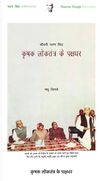
कृषक लोकतंत्र के पक्षधर
लेखक: मधु लिमये
'मधु जी', लोहिया ट्रस्ट, लखनऊ, प्रकाशन ~१९९७-९८. पृष्ट ३४१
मधु लिमये: जन्म ०१ मई १९२२ मृत्यु ०८ जनवरी १९९५. भारतीय राजनीतिज्ञ और समाजवादी आंदोलन के नेताओं में से एक थे। भारत की समाजवादी राजनीति के प्रतिनिधि नेता मधु लिमये ने चार दशक तक देश की राजनीति को कई तरीकों से प्रभावित किया। वह प्रखर वक्ता और सिद्धांतकार थे। तात्कालिक राजनीतिक स्वार्थ के समय ही सुनाई देने वाली श्अंतरात्मा की आवाज़श् के दौर में मधु लिमये लोकतंत्रए आडंबरहीनता और साफ़ सार्वजनिक जीवन के पहरेदार बन गए थे। मधु लिमये ने दुनिया को बताया कि संसद में बहस कैसे की जाती है। उन्होंने सांसद होने की पेंशन कभी नहीं ली और न ही पूर्व सांसद होने की सुविधाएं। मधु लिमये १९७९.१९८२ के बीच चौधरी चरण सिंह के लोक दाल के महासचिव थे ।
Source - https://www.charansingh.org/hi/archives/2013
Books written by Chaudhari Charan Singh (all books are available for free download here) -
Books written on Chaudhari Charan Singh (many books are available for free download here)
Video’s of Chaudhari Charan Singh (1967 till his funeral in 1987)
Audio Interview of Chaudhari Charan Singh
Gallery of Books on Chaudhary Charan Singh
A brief life history of Charan Singh
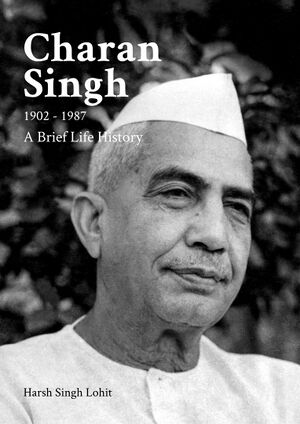
This brief life history of Charan Singh, published by the Charan Singh Archives, takes the reader through the early influences of Swami Dayanand and Mohandas Gandhi on Singh, his immersion in the freedom struggle, his long political life in Uttar Pradesh and subsequently in Delhi, and his abiding importance as an organic intellectual of village India with a complex, sophisticated and coherent strategy for India’s development at variance from all post-Independence governments. A detailed chronology of Singh’s life is a fascinating glimpse of politics in India from the Forties till the Mid-Eighties.
Singh was a man of simplicity, virtue and morals in the Gandhian mould, his upright character and honesty recognised by all. This enabled him a reputation as a strong administrator, an upholder of the law of the land. He believed in a fundamentally democratic society of small producers and small consumers brought together in a system neither socialist or capitalist but one that addressed the uniquely Indian problems of poverty, unemployment, inequality, caste and corruption. Each of these issues remains intractable today, and his solutions as fresh and relevant to their amelioration and ultimate eradication.
A scholar of extraordinary capability, Singh wrote a number of books, political pamphlets and numerous articles in English on his belief of the centrality of villages and agriculture in India’s political economy which are even more relevant to India today as we struggle with an agrarian crisis and 67% of our population in the villages. His first publication was the 611-page report of the Zamindari Abolition and Land Reforms Committee in Uttar Pradesh in 1948. He also wrote, amongst others, Abolition of Zamindari: Two Alternatives (1947), Joint Farming X-Rayed: The Problem and Its Solution (1959), India’s Poverty and Its Solution (1964), India’s Economic Policy: The Gandhian Blueprint (1978) and Economic Nightmare of India: Its Cause and Cure (1981).
“Charan Singh's political life and economic ideas provide an entry-point into a much broader set of issues both for India and for the political and economic development of the remaining agrarian societies of the world. His political career raises the issue of whether or not a genuine agrarian movement can be built into a viable and persistent political force in the 20th century in a developing country. His economic ideas and his political programme raise the question of whether or not it is conceivable that a viable alternative strategy for the economic development of contemporary agrarian societies can be pursued in the face of the enormous pressures for industrialisation. Finally, his specific proposals for the preservation and stabilisation of a system of peasant proprietorship raise once again one of the major social issues of modern times, namely, whether an agrarian economic order based upon small farms can be sustained against the competing pressures either for large-scale commercialisation of agriculture or for some form of collectivisation.
”Brass, Paul. Economic & Political Weekly, 25 Sept 1993. Chaudhuri Charan Singh: An Indian Political Life.
CSA
https://www.facebook.com/charansingharchives/
Now buy Charan Singh’s life history in English on Amazon at https://www.amazon.in/dp/9387280411?ref=myi_title_dp
Note: It it with deep sadness that we inform our readers that Prof. Paul R Brass, an acknowledged American scholar of Indian society and politics, based away on 31 May 2022. He was 85. Paul commenced his academic study of India in 1961 when he first met Chaudhary Charan Singh who was then the Home and Agriculture Minister of Uttar Pradesh. Post this, over the course of the next 3 decades, he formed a close intellectual and personal bond with Chaudhary sahab. This association resulted in one of Paul’s seminal works, a three volume biography of Charan Singh (between 2011 and 2014). Paul was a friend, supporter and an inspiration for the Charan Singh Archives.
We will miss Paul.
Summary of Selected Works by Charan Singh
https://www.amazon.in/dp/B08RWN68CS
Summary of Selected Works by Charan Singh (145 pages) includes summaries of each of 6 key books written by Singh between 1947 and 1986. For the very first time, this Summary brings to light Singh’s deep and wide range of reading from the time of his youth in the 1920s, during his multiple periods of incarceration in British jails during India’s freedom struggle, and then his long period as a legislator and Minister in multiple Government’s in Uttar Pradesh and Delhi in the 1980s. These books gave shape to his economic and political thought over 6 decades of his long public life. The Summary painstakingly re-creates annotated Bibliographies of each book, as well as traces the origins of Singh’s formative Masters education in History at Agra University in the then United Provinces.
The Summary is a companion volume to the comprehensive Selected Works by Charan Singh which is a library set of 6 books written by Singh. A comprehensive introduction to Singh whose ideas remain relevant to an as-yet agrarian India, this Summary is very useful for policy makers, politicians, academicians and students of the political economy of India, development studies and Gandhian followers.
“He [Charan Singh] was exceptional ... in producing a substantial corpus of written work, between 1947 and 1986 which contained a coherent and elaborate set of ideas, encompassing a vision of the nature of rural India and of the road that rural India might best take. He was a genuinely productive intellectual, who distilled in his writing a potent mixture of analysis and prescription. ... thirdly, he possessed a special distinctiveness, in combining a capacity for political action with intellectual activity and facility in conveying ideas.”
Byres, Terence Charan Singh (1902-87): An Assessment. Journal of Peasant Studies, 15:2, 139-189. 1988
“While Russia produced more than a dozen agrarian intellectuals, and China produced a few, Singh may have been independent India’s one and only.’'
Khilnani, Sunil. Incarnations: India in 50 Lives, Charan Singh – A Common Cause. Random Penguin House, 2016. p. 564
With Regards
Harsh Singh Lohit Charan Singh Archives --- CSA https://www.charansingh.org/ https://www.facebook.com/charansingharchives/
Selected Works of Charan Singh
https://www.amazon.in/dp/B08F4J91PR
This collectors set includes 6 of Singh’s major works and an easy-to-read summary of each of these books in the original English. The set makes an ideal acquisition for private and public libraries and is especially useful for students of economics, political economy, Gandhian studies, academicians in general, social and political activists, politicians and policy makers.
Charan Singh proposed a Gandhian political economy – less industrial, more hand- made and self-sufficient local economies – one readers can reacquaint themselves through this collector set. He wrote Abolition of Zamindari (1947), Joint Farming X-Rayed (1959), India’s Poverty and Its Solution (1964), India’s Economic Policy: The Gandhian Blueprint (1978), Economic Nightmare of India (1981) and Land Reforms in U.P. and the Kulaks (1986). The 7th book (Summary of Selected Works) provides easy-to-read summaries of each of these 6 books, and is an excellent accompaniment to the original texts.
All these books plead for the centrality of villages, agriculture and hand-made local industry in India’s political economy. Singh believed deeply in a democratic society of small producers and small consumers brought together in a system neither capitalist or communist but one that addressed, as a whole, the uniquely Indian problems of poverty, unemployment, inequality, caste and corruption. Each of these issues remains intractable today, and his solutions as fresh and relevant to their amelioration and ultimate eradication.
With Regards
Harsh Singh Lohit
Charan Singh Archives
CSA
https://www.facebook.com/charansingharchives/
India's Economic Policy: The Gandhian Blueprint
https://www.amazon.in/dp/B08RYKY94R
Published in 1978 when Charan Singh was Union Home Minister and the Chairman of Janata's Party's Cabinet committee on economic policy, India's Economic Policy: The Gandhian Blueprint lays out an alternate model for India's development. This book is a succinct formulation of Singh's principles to build India from the bottom-up. Singh is critical of Jawarhalal Nehru's economic policy framework and the latter's rejection of Mohandas Gandhi's vision of an India with the village at its center. He prescribes a radically new policy blueprint, on Gandhian lines, in harmony with India's geography, population, demography and democratic beliefs.
His economic policy targets the 'three ills' of poverty, unemployment and disparities in wealth through higher agricultural production, maximisation of employment on land and by capital, reduced inequalities in incomes, and protection of labour from exploitation. Singh's blueprint recommends a reversal of industrialization and the privileges its mostly urban beneficiaries enjoyed over agriculture and the village, and a complete overhaul of urban-elitist planning which had little contact with ground realities.
Singh stresses he is not opposed to industrialisation per se, but to the priority given to it over village India. He opposes mechanisation that replaces human labour, with which India is endowed to excess, as well as to the concentration of economic power it engenders in the hands of a few. He urges a break from foreign technology as well as capital upon which all efforts at development had hitherto been predicated. His Gandhian prescription is the widespread application of labour-intensive techniques and small scale decentralised production, for the most part, all based on democracy engendering self-employment instead of the extractive Capitalist or totalitarian Communist systems.
With Regards
Harsh Singh Lohit
Charan Singh Archives
CSA
https://www.facebook.com/charansingharchives/
Economic Nightmare of India
https://www.amazon.in/dp/B08RXB3VR4
The last of Charan Singh’s major works, Economic Nightmare of India: Its Cause and Cure was published in 1981. This updated Singh’s long-standing critique of the lopsided capital-intensive, industrial and urban-biased development path followed by India since Independence in 1947. Singh strings together, in his usual systematic manner, damning data on growing poverty, malnutrition, unemployment, indebtedness and income inequality in India. He warns of a bleak future unless national priorities change to address the vast majority living in rural India.
Singh takes us through a tour of the land system in India, the neglect of agriculture, the exploitation of the peasant and deprivation of the village by priorities of the urban elite. He juxtaposes the opposing patterns of development envisaged by Gandhi and Nehru, and the ills that ‘Socialist’ thinking brought to society including an inefficient public sector. He also goes on to condemn the concentration of economic power in the hands of a few business families, widening income disparities and unemployment.
Singh champions nationwide self-employment, eschewing models based on communism or capitalism as practiced in other nations, as the basis of a self-sufficient and democratic nation. Singh shares solutions that replace the Nehruvian approach with the Gandhian: focus on the village, agriculture, and rural employment. He marshals arguments in favour of primacy to employment over growth in GDP; decentralised industrialization based on labour-intensive techniques of production; strengthening of the small farm peasant economy and avoiding labour displacing mechanisation of agriculture; increasing investments in social and economic infrastructure in rural areas for education, medical facilities, sanitation, civic amenities to dramatically reduce migration to the slums of the cities.
With Regards
Harsh Singh Lohit
Charan Singh Archives
CSA
https://www.facebook.com/charansingharchives/
A Leader’s Ethics
The story of 6 Rupees and 25 Paisa
A 1967 meeting between Chief Minister of Uttar Pradesh Chaudhary Charan Singh and Haridwar Resident Commissioner Chandrasekhar Dwivedi.
“This story is from 1967, when Chaudhary Charan Singh was chief minister Uttar Pradesh and my father the resident magistrate posted in Haridwar. Haridwar wasn’t yet a district, hence the resident magistrate was pretty much the senior-most officer there. My late father Chandrasekhar Dwivedi was an IAS officer of the Uttar Pradesh cadre, from the PCS batch of 1956 who had been promoted to the IAS. He was a hard-working, upright and forthright officer. Even today it warms my heart when I hear his contemporaries talk about his sterling reputation and his form approach to law and order.
The Chief Minister was expected to reach Haridwar in the day at a pre-appointed time, he was delayed due to some reasons. He instead reached Haridwar very late that night. At that time, there was a Dam bungalow next to the Ganga river which was the residence of the resident magistrate. Right next to it was another bungalow which was a government guest house or the ‘Circuit House’. The Chief Minister stayed at the circuit house that night. None of the government officials knew the Chief Minister was on a fast that day, they came to know too late to make arrangements so my father provided the meal of milk and fruits from home. The tour of the Chief Minister was for 2 days, he kept busy with his official program including meeting the Commissioner of Saharanpur and workers from his political party.
My father narrated to us that a good thing about Charan Singh was his strong administrative capability. He kept a keen watch on the smallest of issues. He was particular about pulling-up officers when matters in their areas of responsibility were not up to the mark by his standards. He would say so-and-so is not happening on your district, this is what you should be doing, I as the Chief Minister know more then you about what's going on and so on. However, he was also very particular about rewarding and appreciating a good and upright officer. Charan Singh’s primary objective was the good of the state from an administrative viewpoint, implementation of what was good for the public, the duty of an officer, his dharma, what the officer needed to do to execute his responsibilities including being alert and knowledgeable on the ground.
Anyways, Charan Singh’s tour completed in two days and he was in his first-class cabin while the train was waiting to depart from the Haridwar station and he asked for the Resident Magistrate to be sent to him. My father reached Charan Singh who was alone in his cabin, wished him with a namaste, and was asked to sit across on the seat opposite. He took out a check already made out for six rupees and twenty five paise, wrote Chandrasekhar Dwivedi on the check and gave it to my father. He said RM sahab, please keep this. My father was obviously very taken aback that the chief minister was giving him a check, he asked what is this for. Charan Singh said “I had come the other day in the night and stayed at the Dak Bungalow and was informed that the fruits and milk had been sent from your home on a personal basis so this 6 rupees and 25 paise is for those fruits and milk that you were kind enough to send for me.” My father said “No Sir, this is not at all required, I mean I am a brahmin so I fully understand the importance of a fast, you were inordinately delayed that night and no one knew it was your fast that day, hence it was just a gesture, my house is right next door, so whatever I could organise immediately I did.” Charan Singh said “I appreciate what you did, your thoughtfulness about understanding the importance of my fast at midnight, but you just have to take this check.”
He was after all the Chief Minister, it was not possible to refuse him, and father accepted the check. The Chief Minister asked a few questions about Haridwar and related issues and my father gave him reasonable answers. The Chief Minister left, the train went its way.
My father never deposited that check.
He died in 2016 January and held that check all those years, he kept it perhaps as a commendation, a memorabilia, as something to remember; he never presented that check at a bank. In some days Charan Singh transferred my father to Lucknow and appointed him to a responsible post because he felt here was a good administrative officer, he works sincerely. Charan Singh had anyways checked on my father’s reputation on his own.
What I mean to bring out through this episode is the character and conviction of a Chief Minister, where a man like Charan Singh who had just eaten some fruits and milk from some officer gave money for this gesture."
Source: Harsh Singh Lohit, Charan Singh Archives
Charan Singh (1902-1987): An Assessment
1988 Terence J. Byres Charan Singh (1902-1987) An Assessment.pdf
Terence Byres
Terence Byres, a Marxist academic and peasant studies scholar, at the Department of Economic and Political Studies, School of Oriental and African Studies, University of London, published this well researched paper in 1988 in the Journal of Peasant Studies, 15:2, 139-189. Byres surprisingly accurate and detailed research and analysis indicates his knowledge of the Indian political economy and his insightful reading of primary and secondary material. This paper was widely printed and distributed in India when it was published shortly after Charan Singh’s demise in 1987, and till today remains the seminal Marxist critique of Charan Singh.
While recognizing Charan Singh’s achievements and identifying what the author thinks were his class loyalties, he brings out a hitherto unacknowledged aspect of Charan Singh as “ the ‘organic intellectual’ of the rich and middle peasantry.” This was a rare acceptance of Charan Singh’s unique intellectual abilities, one that even today few of the educated elite are aware of.
One of the key objectives of the CSA is to highlight the intellect of Charan Singh and his publications, which Byres clearly does while effectively pushing his Marxist positions. Charan Singh’s books and positions on the political economy of India are unique for a practicing grassroots politician in any nation, not just in India. Few politicians are capable to be both an effective representative of the people who elect him and be a scholar of any level while being immersed in the rough and tumble of grassroots politics. Charan Singh was both, and an excruciatingly honest and efficient administrator to boot.
Byres did not perhaps read enough outside of the books he has listed as written by Charan Singh, though he was one of the few scholars (in India or overseas) who seemed to have read the entire impressive list of primary material in the bibliography. If he had read more, however, he would have found the many places where Charan Singh explained his views on land reform: abolition of landlordism versus land re-distribution; his approach to the development of the village economy and agriculture; and his virulent opposition to caste and its ugly manifestations in rural life.
Charan Singh was often called out as a Kulak – pejoratively, of course – by Indian communists, and he himself had no love lost for them. In fact, if anything, he was solidly anti-communist in his politics though he admired the Spartan existence and simple lives Indian communist leaders – like Harkishen Singh Surjeet - led. That does not at all mean that he was a capitalist, neither was he ever a socialist. For example, he opposed the public sector for its sloth and corruption and wanted this to be handled by the private sector, but he equally opposed large capitalists and the extreme inequality he saw inherent in the development of capitalism. He was no friend of the bureaucracy or indeed organised labor as he saw them as the privileged and pampered elite of their class.
Charan Singh chose solutions that he thought were best suited to Indian conditions, which to his mind were rural and village based at the core. Gandhian thought influenced him greatly, and he was attacked there too by the neo-capitalist class as ‘backward’.
It serves little purpose to debate Byres paper and class approach in this brief introduction, as Charan Singh himself has given these answers in many places and had fought accusations of bias against the lower castes his entire life. To say that there is no bias in the village by the middle and high castes against the low castes is laughable, but our cursed caste system is such that there is a hierarchy even within the lowest.
Everyone kicks down, and sucks up just like in a good corporation. A leader has to take all castes along to be successful in grassroots politics, but it is Charan Singh’s place in history to have commenced in the 1970s the consolidation of the ‘other backward castes’ in North India and steered them away from the Indian National Congress, which has brought the Congress to the sorry pass it is today. Charan Singh no doubt wanted to take all castes in the village along, but that he was not able to as much as he desired was the result of the caste system itself and the price of his outstanding success with the peasantry – marginal, small and medium.
1988 Terence J. Byres Charan Singh (1902-1987) An Assessment.pdf
Harsh Singh Lohit Charan Singh Archives --- CSA https://www.charansingh.org/ https://www.facebook.com/charansingharchives/
Charan Singh and Green Revolution in Uttar Pradesh: A talk
A talk in English by historian Prof. Prakash Kumar of Univ of Pennsylvania USA on a rare topic - Ch Charan Singh and his view of the Green Revolution is available on YouTube - https://youtu.be/x9vkskOpcfs.
Harsh Lohit met with Prakash and shared the perspectives of the Archives, as well as shared a lot of reading material. The Archives continue to engage with academia on the views and life of Charan Singh. It is a very useful talk on the subject.
Abolition of Zamindari
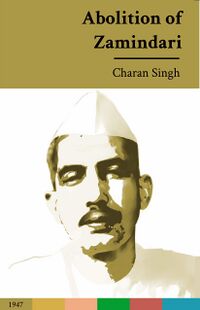
https://www.amazon.in/dp/B08RX8Q82P
Published in 1947 when Charan Singh was a Member of the Indian National Congress’ Zamindari Abolition and Land Reforms Committee (ZALRC) in Uttar Pradesh, Abolition of Zamindari: Two Alternatives details Singh’s case and method for ending landlordism. He was, in fact, to become the principal architect of the ending of zamindari in Uttar Pradesh as Minister of Revenue in the 1950s.
Singh deploys his considerable knowledge of the land tenure system, the psyche of the Indian peasant and literature from across the world to identify alternatives for the removal of zamindari available to India. He proposes a solution from the bottom up, positing the self-cultivating small peasant and decentralized village industry as the cornerstone of an economic policy uniquely suited to the problems of the nascent Indian nation.
Singh’s vision, based on the primacy of peasant owner-cultivators, is organically opposed to the Marxist model as practiced then in Soviet Russia and popular in intellectual and political circles in India of the time. His commitment to a democratic Indian future is absolute, and in search for an equitable society he recommends radical land reforms and a restructuring of Indian agriculture based on intensive utilization of land, coupled with an emphasis on small-scale machinery augmenting labour, employing millions in the process.
With Regards
Harsh Singh Lohit Charan Singh Archives --- CSA https://www.charansingh.org/ https://www.facebook.com/charansingharchives/
Joint Farming X-rayed
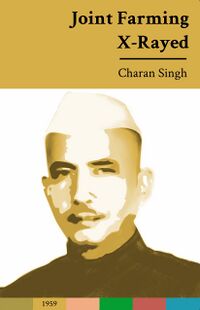
https://www.amazon.in/dp/B08T6L9R1M
Written in opposition to the adoption of joint farming as India’s agricultural policy at the Indian National Congress’ Nagpur Resolution of January 1959, which was a culmination of high-pitched propaganda led by Jawaharlal Nehru in favour of collective/cooperative farming, Joint Farming X-rayed presents Charan Singh’s substantive intellectual break with the political party he had served for 35 years.
Published in September 1959, this is a devastating critique of joint farming as a means of increasing agricultural productivity. Singh finds it unsuitable for the Indian countryside based on varied geography, limited land and capital, a complex social structure, a vast population and commitment to democratic principles. He also brings to bear an extraordinary amount of evidence from multiple continents and numerous disciplines to present a picture of the havoc collectivisation unleashes on farm productivity, in which he presciently anticipates the failure of collective farms across the Communist world.
His alternate vision identifies land as the limiting factor in capital production, and posits agriculture, not industry, as the priority for sustainable capital formation. The book locates independent small owner-cultivators, decentralised village industries, intensive farming and population control as the solutions for India. Singh puts forth a cogent plan for a new India constructed from the bottom-up, in opposition to the Nehruvian top-down plan aping alien models unsuited to her genius and limitations, made by men who Singh considered were themselves alienated from the ground realities of the country.
With Regards
Harsh Singh Lohit
Charan Singh Archives --- CSA https://www.charansingh.org/ https://www.facebook.com/charansingharchives/
Land Reforms in U.P and the Kulaks
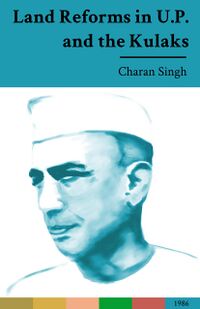
https://www.amazon.in/dp/B08RXBJCPD
Published a year before his passing in 1987, Charan Singh’s last work, Land Reforms in U.P and the Kulaks chronicles Singh’s relentless struggle over three decades (1936-66) in favour of small farms and his battles for the abolition of Zamindari in the face of bitter opposition from the landed aristocracy.
As Parliamentary Secretary in 1946 and later Revenue Minister in 1952 in Uttar Pradesh (U.P.), he led the movement for abolishing the Zamindari system, supported fully by the Chief Minister Govind Ballabh Pant. Singh cites the Zamindari Abolition and Land Reforms (ZALR) Act of 1951, researched, written and shepherded into law and implemented by him, as the proudest achievement of his political career. His unparalleled knowledge of the complex set of land tenure laws in U. P. was instrumental in warding off determined attacks from opponents across the political spectrum.
The ZALR Act provided small tenant cultivators with permanent and inalienable rights to the land they tilled; and in conjunction with the Consolidation of Holding Act (formulated and passed into law again by Singh in 1953) ensured they became a bulwark of democracy and of higher agricultural productivity. He demonstrates the lengths to which this legislation went on to protect rural and interests of the downtrodden against urban greed, corruption and legal sabotage instigated by the landlords and their rural collaborators.
His writing reveal a deep understanding of the tenant’s view of land reforms, as well as an intimate understanding of the psychology and ethos of the Indian countryside. Singh considered this empathy lacking in his political contemporaries, whether capitalist, socialist or communist, and to whom he returns the charge of being the real Kulaks.
With Regards
Harsh Singh Lohit
Charan Singh Archives
CSA
https://www.facebook.com/charansingharchives/
List of Publications by Charan Singh Archives
Charan Singh was born on 23 December 1902 in Meerut District of the then United Provinces (Uttar Pradesh) in an illiterate tenant farmer’s village hut. His mental fortitude and intellectual ability were recognised early in life and he went on to acquire a B.Sc., M.A. in History and LL. B from Agra College. He joined the Indian National Congress at 27 in the struggle to free India from British rule and was imprisoned in 1930, 1940, and 1942 for his participation in the national movement. He remained a member of the Legislative Assembly of Uttar Pradesh from 1936 to 1974 and was a minister in all Congress governments from 1946 to 1967 which provided him a reputation as a clean and clear-headed administrator and upholder of the law of the land. Singh was the state’s first non-Congress Chief Minister in 1967 and again in 1970, before his tenure in 1977 in the Union Government as Cabinet Minister for Home and then Finance. This journey culminated in 1979, when he was made Prime Minister of India. Over much of the 70s and early 80s he remained a figure of major political significance in Indian politics and passed away on 29 May 1987.
The Charan Singh Archives (CSA) were established on 23 December 2015 (visit www.charansingh.org) to document Charan Singh’s intellectual legacy. CSA publicly shares and interprets the extensive material available on his life and intellect. It highlights Charan Singh’s commitment to leading an ethical life, his championship of agriculture and the rural in the Indian development discourse and in politics, his life-long belief in non-agricultural job creation in rural India as the appropriate solution for livelihoods, land reforms and social justice based on a community of shared economic interests in place of religion or caste. CSA publishes books written by and on Charan Singh, details of which are given in the following pages. Questions? Please call Yashveer Singh on 9810403866 or email info@charansingh.org
List of Publications by Charan Singh Archives: 15 August 2022
- Selected Works of Charan Singh
- Summary of Selected Works
- Abolition of Zamindari
- Joint Farming X-rayed
- India’s Poverty and its Solution
- India’s Economic Policy
- Economic Nightmare of India
- Land Reforms in U.P and the Kulaks
- Charan Singh: A Brief Life History
- चरण सिंह एक संक्षिप्त जीवनी
- शिष्टाचार
- विशिष्ट रचनाएं
- एक ऐतिहासिक सिंहनाद
- आर्थिक विकास के सवाल और बौद्धिक
The Charan Singh Archives published the ‘Selected Works of Charan Singh’ in 2020. This collectors set includes 6 of Singh’s major works and an easy-to-read summary of each of these books in the original English. CSA dedicated these books to the memory of those who sought a new dawn for India in Gandhiji’s Swaraj as a peaceful spiritual, political and social revolution.
The set makes an ideal acquisition for private and public libraries and is especially useful for students of economics, political economy, Gandhian studies, academicians in general, social and political activists, politicians and policy makers.
The contemporaneity of Charan Singh’s ideas informs us how little India has changed since Independence as we struggle with an agrarian crisis where 47% of our impoverished population remains engaged in non-remunerative agricultural livelihoods. When COVID struck at the heart of human activity in 2020, the ugly innards of the urban, post-industrial exploitative structure lay fully exposed as our rural brothers and sisters fled the slums of the cities for their villages from where they had migrated to earn a living. In Singh’s ideal world, the regeneration of rural India would have replaced the megacities that are being constructed and these would not have become the capital sinks of an ecologically unsustainable life.
As we enter 2021 CE, a farmers agitation for repealing three laws related to procurement of their produce has morphed into a struggle for an agricultural way of life. Ironically, the APMC law the farmers from Punjab are fighting to retain was passed in 1937 by Sir Chhotu Ram, the making of which Singh had a historical role.
Charan Singh proposed a Gandhian political economy – less industrial, more hand- made and self-sufficient local economies – one readers can reacquaint themselves through this collector set. He wrote Abolition of Zamindari (1947), Joint Farming X-Rayed (1959), India’s Poverty and Its Solution (1964), India’s Economic Policy: The Gandhian Blueprint (1978), Economic Nightmare of India (1981) and Land Reforms in U.P. and the Kulaks (1986). The 7th book (Summary of Selected Works) provides easy-to-read summaries of each of these 6 books, and is an excellent accompaniment to the original texts.
In addition to these, Singh wrote scores of books, pamphlets and hundreds of articles on the need for centrality of villages and agriculture in India’s political economy and planning. His ideas proposed less industrial, more hand-made and self-sufficient rural and local economies in India.
All these books plead for the centrality of villages, agriculture and hand-made local industry in India’s political economy. Singh believed deeply in a democratic society of small producers and small consumers brought together in a system neither capitalist or communist but one that addressed, as a whole, the uniquely Indian problems of poverty, unemployment, inequality, caste and corruption. Each of these issues remains intractable today, and his solutions as fresh and relevant to their amelioration and ultimate eradication.
Charan Singh was born on 23 December 1902 in Meerut District of the United Provinces (Uttar Pradesh) in an illiterate tenant farmer’s village hut. His mental fortitude and capability were recognised early in life and he went on to acquire a B.Sc., M.A. in History and LL. B from Agra College. He joined the Indian National Congress, at 27, in the struggle to free India from British rule and was imprisoned in 1930, 1940, and 1942 for his participation in the national movement. He remained a member of the Legislative Assembly of Uttar Pradesh from 1936 to 1974 and was a minister in all Congress governments from 1946 to 1967, which provided him a reputation as an efficient, incorruptible and clear- headed administrator. Singh was the state’s first non- Congress Chief Minister in 1967 and again in 1970, before his tenure in 1977-78 as the Union Minister for Home and, later, Finance. This journey culminated in 1979 when he became Prime Minister of India. Over much of the 70s and early 80s he remained a figure of major political significance in Indian politics till he passed away on 29 May 1987.
Charan Singh wrote scores of books, political pamphlets, manifestoes and hundreds of articles on the centrality of the village and agriculture in India’s political economy. Many of these thoughts are relevant to India today as we struggle with an agrarian crisis with 67% of our impoverished population living in the villages and 47% engaged in unremunerative agricultural livelihoods. He helped write the 611 – page report of the Zamindari Abolition and Land Reforms Committee in Uttar Pradesh in 1948 and also wrote the books Abolition of Zamindari (1947), Joint Farming X-Rayed (1959), India’s Poverty and Its Solution (1964), India’s Economic Policy (1978) Economic Nightmare of India (1981) and Land Reforms in U.P. and the Kulaks (1986).
Published in 1947 when Charan Singh was a Member of the Indian National Congress’ Zamindari Abolition and Land Reforms Committee (ZALRC) in Uttar Pradesh, Abolition of Zamindari: Two Alternatives details Singh’s case and method for ending landlordism. He was, in fact, to become the principal architect of the ending of zamindari in Uttar Pradesh as Minister of Revenue in the 1950s.
Singh deploys his considerable knowledge of the land tenure system, the psyche of the Indian peasant and literature from across the world to identify alternatives for the removal of zamindari available to India. He proposes a solution from the bottom up, positing the self-cultivating small peasant and decentralized village industry as the cornerstone of an economic policy uniquely suited to the problems of the nascent Indian nation.
Singh’s vision, based on the primacy of peasant owner-cultivators, is organically opposed to the Marxist model as practiced then in Soviet Russia and popular in intellectual and political circles in India of the time. His commitment to a democratic Indian future is absolute, and in search for an equitable society he recommends radical land reforms and a restructuring of Indian agriculture based on intensive utilization of land, coupled with an emphasis on small-scale machinery augmenting labour, employing millions in the process.
Written in opposition to the adoption of joint farming as India’s agricultural policy at the Indian National Congress’ Nagpur Resolution of January 1959, which was a culmination of high-pitched propaganda led byjawaharlal Nehru in favour of collective/cooperative farming, Joint Farming X-rayed presents Charan Singh’s substantive intellectual break with the political party he had served for 35 years.
Published in September 1959, this is a devastating critique of joint farming as a means of increasing agricultural productivity. Singh finds it unsuitable for the Indian countryside based on varied geography, limited land and capital, a complex social structure, a vast population and commitment to democratic principles. He also brings to bear an extraordinary amount of evidence from multiple continents and numerous disciplines to present a picture of the havoc collectivisation unleashes on farm productivity, in which he presciently anticipates the failure of collective farms across the Communist world.
His alternate vision identifies land as the limiting factor in capital production, and posits agriculture, not industry, as the priority for sustainable capital formation. The book locates independent small owner-cultivators, decentralised village industries, intensive farming and population control as the solutions for India. Singh puts forth a cogent plan for a new India constructed from the bottom-up, in opposition to the Nehruvian top-down plan aping alien models unsuited to her genius and limitations, made by men who Singh considered were themselves alienated from the ground realities of the country.
Published in 1964, India’s Poverty and its Solution is Charan Singh’s most substantive work. It lays out his clear ideological position on the need for a primarily agricultural society to give primacy to agriculture for inter-related social, economic, political and ecological reasons.
An update of his 1959 book Joint Farming X-rayed, which was written in opposition to the adoption of large scale co-operative farming as India’s agricultural policy by the Indian National Congress, Singh bolsters his devastating critique of joint farming with updated figures and tables.
Singh reiterates that the system of peasant proprietorship is best suited to India’s economic and social development, with small farms forming a bulwark of democracy, and also the basis of a certain way of life quite in contrast to industrialisation. Singh details an alternative model for India’s bottom-up economic development based on decentralised village industries, agricultural self-sufficiency and enhanced purchasing power of the vast majority of Indians dwelling in the villages.
Published in 1978 when Charan Singh was Union Home Minister and the Chairman of Janata’s Party’s Cabinet committee on economic policy, India’s Economic Policy: The Gandhian Blueprint lays out an alternate model for India’s development. This easy-to-read book is a succinct formulation of Singh’s principles to build India from the bottom-up. Singh is critical of Jawarhalal Nehru’s economic policy framework and the latter’s rejection of Mohandas Gandhi’s vision of an India with the village at its center. He prescribes a radically new policy blueprint, on Gandhian lines, in harmony with India’s geography, population, demography and democratic beliefs.
His economic policy targets the ‘three ills’of poverty, unemployment and disparities in wealth through higher agricultural production, maximisation of employment on land and by capital, reduced inequalities in incomes, and protection of labour from exploitation. Singh’s blueprint recommends a reversal of industrialization and the privileges its mostly urban beneficiaries enjoyed over agriculture and the village, and a complete overhaul of urban-elitist planning which had little contact with ground realities.
Singh stresses he is not opposed to industrialisation per se, but to the priority given to it over village India. He opposes mechanisation that replaces human labour, with which India is endowed to excess, as well as to the concentration of economic power it engenders in the hands of a few. He urges a break away from foreign technology as well as capital upon which all efforts at development had hitherto been predicated. His Gandhian prescription is the widespread application of labour- intensive techniques and small scale decentralised production, for the most part, all based on democracy engendering self-employment instead of the extractive Capitalist or totalitarian Communist systems.
The last of Charan Singh’s major works, Economic Nightmare of India: Its Cause and Cure was published in 1981. This updated Singh’s long-standing critique of the lopsided capital-intensive, industrial and urban-biased development path followed by India since Independence in 1947. Singh strings together, in his usual systematic manner, damning data on growing poverty, malnutrition, unemployment, indebtedness and income inequality in India. He warns of a bleak future unless national priorities change to address the vast majority living in rural India.
Singh takes us through a tour of the land system in India, the neglect of agriculture, the exploitation of the peasant and deprivation of the village by priorities of the urban elite. He juxtaposes the opposing patterns of development envisaged by Gandhi and Nehru, and the ills that ‘Socialist’ thinking brought to society including an inefficient public sector. He also goes on to condemn the concentration of economic power in the hands of a few business families, widening income disparities and unemployment.
Singh champions nationwide self-employment, eschewing models based on communism or capitalism as practiced in other nations, as the basis of a self- sufficient and democratic nation. Singh shares solutions that replace the Nehruvian approach with the Gandhian: focus on the village, agriculture, and rural employment. He marshals arguments in favour of primacy to employment over growth in GDP; decentralised industrialization based on labour-intensive techniques of production; strengthening of the small farm peasant economy and avoiding labour displacing mechanisation of agriculture; increasing investments in social and economic infrastructure in rural areas for education, medical facilities, sanitation, civic amenities to dramatically reduce migration to the slums of the cities.
Published a year before his passing in 1987, Charan Singh’s last work, Land Reforms in U.P and the Kulaks chronicles Singh’s relentless struggle over three decades (1936-66) in favour of small farms and his battles for the abolition of Zamindari in the face of bitter opposition from the landed aristocracy.
As Parliamentary Secretary in 1946 and later Revenue Minister in 1952 in Uttar Pradesh (U.P.), he led the movement for abolishing the Zamindari system, supported fully by the Chief Minister Govind Ballabh Pant. Singh cites the Zamindari Abolition and Land Reforms (ZALR) Act of 1951, researched, written and shepherded into law and implemented by him, as the proudest achievement of his political career. His unparalleled knowledge of the complex set of land tenure laws in U. P. was instrumental in warding off determined attacks from opponents across the political spectrum.
The ZALR Act provided small tenant cultivators with permanent and inalienable rights to the land they tilled; and in conjunction with the Consolidation of Holding Act (formulated and passed into law again by Singh in 1953) ensured they became a bulwark of democracy and of higher agricultural productivity. He demonstrates the lengths to which this legislation went on to protect rural and interests of the downtrodden against urban greed, corruption and legal sabotage instigated by the landlords and their rural collaborators.
His writing reveal a deep understanding of the tenant’s view of land reforms, as well as an intimate understanding of the psychology and ethos of the Indian countryside. Singh considered this empathy lacking in his political contemporaries, whether capitalist, socialist or communist, and to whom he returns the charge of being the real Kulaks.
This brief life history of Charan Singh takes the reader through the early influences of Swami Dayanand and Mahatma Gandhi on Singh, his immersion in the freedom struggle, his long political life in Uttar Pradesh and Delhi, and his abiding importance as an organic intellectual of village India with a complex, sophisticated and coherent strategy for India’s development at variance from all post-Independence governments. A detailed chronology of Singh’s life is a fascinating glimpse of politics in India from the Forties till the Mid-Eighties.
Singh was a man of simplicity, virtue and morals in the Gandhian mould, his upright character and honesty recognised by all. This enabled him a reputation as a strong administrator, an upholder of the law of the land. He believed in a fundamentally democratic society of small producers and small consumers brought together in a system neither socialist or capitalist but one that addressed the uniquely Indian problems of poverty, unemployment, inequality, caste and corruption. Each of these issues remains intractable today, and his solutions as fresh and relevant to their amelioration and ultimate eradication.
A scholar of extraordinary capability, Singh wrote a number of books, political pamphlets and numerous articles in English on his belief of the centrality of villages and agriculture in India’s political economy which are even more relevant to India today as we struggle with an agrarian crisis and 67% of our population in the villages. His first publication was the 611-page report of the Zamindari Abolition and Land Reforms Committee in Uttar Pradesh in 1948. He also wrote, amongst others, Abolition of Zamindari: Two Alternatives (1947), Joint Farming X-Rayed: The Problem and Its Solution (1959), India’s Poverty and Its Solution (1964), India’s Economic Policy: The Gandhian Blueprint (1978) and Economic Nightmare of India: Its Cause and Cure (1981).
Interview with Nehru Memorial Museum and Library
https://charansingh.org/archives/interview-nehru-memorial-museum-and-library
In the original Hindi and translated to English for the first time.
This interview with Ch. Charan Singh is a part of the ‘Oral History Interview’ project of the Nehru Memorial Museum and Library undertaken by Mr. Shyamlal Manchanda in 1972.
This interview was held in Lucknow, Uttar Pradesh on 10 February 1972 when Charan Singh was the President of the Bhartiya Kranti Dal (BKD) and was the leader of the opposition in the UP State Assembly. This is one of the rare interviews of Charan Singh in which he speaks of the influences of the Arya Samaj in his early life, his early career as a lawyer in Ghaziabad city, the influence of the Tyagi community, the elections of 1937 and 1946, the Quit India movement, the state of the Congress after independence, his comments on the policies of the Congress Government in UP in 1937, land ceiling, Acharya Narendra Dev, Rafi Ahmad Kidwai, Sardar Patel, Govind Ballabh Pant and his memories of other leaders.
Chaudhary Charan Singh Interview Lucknow 10 Feb 1972
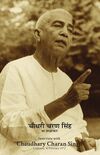
https://www.amazon.in/dp/8196262523
This historical interview is available to us thanks to the far-sighted Oral History program of the Nehru Memorial Museum and Library (NMML), Delhi. Chaudhary Charan Singh shares memories of his early life and the abiding influences of the character and programs of Swami Dayanand Saraswati and Mahatma Gandhi; his long and deep association with the Indian National Congress since 1930 when he first headed the Meerut District Congress Committee; his participation in the long non-violent struggle for freedom from colonial Britain including his multiple periods of incarceration; his career as a young lawyer in Ghaziabad in the 1930s; his views on the downfall of the character and morality of Congressmen soon after Independence in 1947; the poor state of the administration in Uttar Pradesh; his experience in government and his recollections of national and regional political leaders including Jawaharlal Nehru, Vallabhbhai Patel and Govind Ballabh Pant.
With Regards
Harsh Singh Lohit Charan Singh Archives --- CSA https://www.charansingh.org/ https://www.facebook.com/charansingharchives/
Publications of the Charan Singh Archives
Since establishing the Charan Singh Archives in December 2015, we have identified scores of publications around the life and intellectual legacy of Chaudhary Charan Singh many of which remain relevant to India today. The initial publication took us 5 years: identification of the 6 major books he wrote, collecting the original versions, having each re-typed and proofed thoroughly; the bibliographies and references checked and authenticated by scholars. These books were re-designed, typeset and printed as a set. Alongwith this, we summarised each of these 6 books after a detailed study and published a Summary of Selected Works. These 7 books were published in 2020 as part of a comprehensive set for libraries 'Selected Works of Charan Singh’.
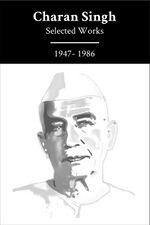
CSA now has 16 publications in print and available on Amazon in India, most recently including 2 volumes of the Hindi translations of Professor Paul Brass’ biographical work of Ch. Charan Singh ‘An Indian Political Life’. Susan Brass has kindly allowed us to publish and distribute these.
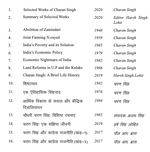
We propose to publish steadily from over 200,000 pages of archival material at the Nehru Memorial Museum and Library donated by Ch. Charan Singh’s family since 1992. Some plans underway are: an unpublished manuscript on the breakup of the Janata Party in 1979; authenticated books written on his life in Hindi; a collection of his public speeches from All India Radio, from print media, as well as from the rich collection at the Uttar Pradesh Legislative Assembly; another on his oral and written interviews; one on the scores of articles he wrote in Hindi and English in media; and the well-thought out manifestos of the political parties he founded. In each book, we plan to add photographs from his life.
We look forward to your support by purchasing these publications and sharing them with people in your networks.
With best wishes
Harsh Singh Lohit
Charan Singh Archives
--- CSA https://www.charansingh.org/ https://www.facebook.com/charansingharchives/
Picture Gallery
Images of Chaudhary Charan Singh
-
Chaudhari Charan Singh
-
Prime Minister Ch. Charan Singh, 1.8.1979
-
Prime Minister Ch. Charan Singh
-
Chaudhary Charan Singh
-
Chaudhary Charan Singh
-
Chaudhary Charan Singh
-
Self Study by Chaudhary Charan Singh
-
Chaudhary Charan Singh in deep thinking
Chaudhary Charan Singh's family
-
Chaudhary Charan Singh's father Ch. Meer Singh & mother Smt Netra Kaur
-
Chaudhary Charan Singh's father Ch. Meer Singh & mother Smt Netra Kaur
-
Chaudhary Charan Singh with father Ch. Meer Singh & mother Smt Netra Kaur, and son Ajit Singh
-
Chaudhary Charan Singh with wife Gayatri Devi
-
Chaudhary Charan Singh with wife Gayatri Devi
-
Chaudhary Charan Singh with wife Gayatri Devi
-
Chaudhary Ajit Singh son of Charan Singh
-
Radhika Singh wife of Ajit Singh seen with Charan Singh (first-row middle)
-
Radhika Singh wife of Ajit Singh seen with Charan Singh (second-row middle)
-
Jayant Chaudhary grandson of Charan Singh
-
Jai Pal Singh and his wife Vedvati, daughter of [[Charan Singh], 1959
-
Charan Singh in marriage of Govind Sing's daughter at Kashipur 17.1.1977
-
Charan Singh in marriage of Govind Sing's daughter at Kashipur 18.1.1977 along with Smt Suman, Dr Ajay Chaudhary, Sau. Madhu and Govind Singh
-
Charan Singh with family in breakfast
-
Gayatri Devi with Virendra Singh and Hari Singh
-
Jayant Chaudhary and his wife Smt. Charu Chaudhary
Chaudhary Charan Singh in Public Life
-
Charan Singh Arya Samaj Ghaziabad, 1929
-
Charan Singh Forest Minister UP, Bhagwan Singh IAS Forest Secretary, Kosani Guest House Almora, June 1964
-
Daulat Ram Saran with Charan Singh and Kumbha Ram Arya in Rajasthan Janta Party Adhiveshan 1965
-
Charan Singh taking Auth of CM UP with Governor Vishvanath Das 3.4.1967
-
Charan Singh with Governor and Cabinet after becoming CM UP
-
Charan Singh heading to Vidhansabha after becoming of CM UP
-
Charan Singh after becoming CM UP
-
Thanks giving by Charan Singh after becoming CM UP , 17.2.1970
-
Charan Singh being honoured after becoming CM 1970
-
Charan Singh coming out after becoming CM 1970
-
Charan Singh busy in official work of CM UP.
-
Charan Singh in fruit exhibition 5.9.1970
-
Charan Singh with Gayatri Devi and Mulayam Singh
-
Charan Singh with Prof B L Kapoor VC Meerut University and Dr Ishwar Singh Meerut, 1970
-
Charan Singh with Prof B L Kapoor VC Meerut University and Dr Ishwar Singh Meerut in inauguration of Homeopathic Clinic, 1970
-
Satya Prakash Malaviya and Charan Singh , 12 Tughlak Road, Delhi
-
Satya Prakash Malaviya and Charan Singh with others 12 Tuglak Road Delhi
-
Charan Singh with Mahak Singh and Satya Prakash Malaviya at Baraut
-
Charan Singh with Omveer Singh at Hapur addressing meeting
-
Chief guest Charan Singh with Nilam Sanjiva Reddy laying foundation at Surajmal Memorial Education Society on 12.12.1978
-
Charan Singh with Ramniwas Mirdha
-
Charan Singh with Indira Gandhi and Gayatri Devi on birthday celebration of Jayant Chaudhary 7.1.1979
-
Charan Singh with Indira Gandhi on birthday celebration of Jayant Chaudhary 7.1.1979
-
Charan Singh marked Tilak by Yogendrapal Yogi before going to take auth of PM on 28.7.1979
-
Charan Singh with Jagjiwan Ram
-
Charan Singh with Ajay Singh
-
Charan Singh with Atal Behari Bajpaiyee in a farmer gathering
-
Charan Singh with Subramanian Swamy
-
Charan Singh with Satya Prakash Malviya Lokdal Sammelan, 1985
-
Charan Singh with Sharad Yadav and Sh Bahuguna at a Lokdal Rashtriya Shivir Vrindavan-1985
-
Charan Singh and Gayatri Devi with Chandrawati Sheoran
Prime Minister Ch. Charan Singh (28.7.1979-14.1.1980)
-
Ch. Charan Singh reading letter given to him by Pesident N Sanjeeva Reddy to form government, 20.7.1979
-
Charan Singh with President Neelam Sanjiva Reddy taking auth of vth PM of India on 28.7.1979
-
Prime Minister Ch. Charan Singh at Raj Ghat before proceeding to Red Fort, 30.7.1979
-
Ch. Charan Singh's address at Red Fort 15 August 1979
-
Prime Minister Ch. Charan Singh at Work in PMO, 1.8.1979
-
Charan Singh with Devi Lal at Boat Club Delhi Kisan Rally 23.12.1979
-
Charan Singh at Boat Club Delhi Kisan Rally 23.12.1979
-
Charan Singh at Boat Club Delhi Kisan Rally 23.12.1979
-
Charan Singh at Boat Club Delhi Kisan Rally 23.12.1979
-
Charan Singh with Armed Forces Staff, 7.12.1979
-
Charan Singh with Kosigin, PM of Russia
-
Charan Singh with UNO Senate Member Charles Parsi on 6.8.1979
-
Charan Singh inaugurating training for Rural Youth on 15.8.1979
-
Charan Singh with Foreign Minister of Egypt on 17.8.1979
-
Charan Singh addressing officers on 4.10.1979 at Lucknow
-
Charan Singh and Gayatri Devi with GD Tapase Governor UP on 4.10.1979
-
Charan Singh with Nepal Naresh in a dinner party on 21.9.1979
Prime Minister Ch. Charan Singh:Monuments
-
The Last Journey - 29.5.1987 - 12 Tughlak Road New Delhi, Tribute being paid by son Ajit Singh and daughters
-
PM Narsimha Rao, paying tribute to Charan Singh on his vth death anniversary, 29.5.1992
-
President R Venkat Raman Paying homage to Charan Singh on vth death anniversary, 29.5.1992
-
Vice President Shankar Dayal Sharma Paying homage to Charan Singh on vth death anniversary,29.5.1992
-
Sign Board of parental village Bhadaula
-
Chaudhari Charan Singh Library - Noorpur - Ghaziabad
-
Lal Krishna Adwani paying tribute to Charan Singh on his 110 th birth anniversary at Loksabha along with Central Minister Ajit Singh, MP Jayant Chaudhari and others
-
Chaudhary Charan Singh Statue founded at Airport Lucknow by Foreign Minister Shalman Khurshid, Governor BL Joshi, son Ajit Singh and MP Jayant Chaudhari
-
Ch. Charan Singh University Meerut
-
Daulat Ram Saran in Chaudhari Charan Singh Janm Shatabdi Varsh 1-3 Jan 2002 at Nawalgarh
-
MLA Narendra Singh Paying homage at Chhaproli
-
Prof Mahak Singh Paying Homage at Kisan Ghat
-
पुण्य तिथि 29.5.2021 पर हवन करते अनुयाई ।
-
यह मूर्ति वसुन्धरा गाजियाबाद उत्तर प्रदेश में स्थापित है।
Ch. Charan Singh in News/Articles
-
-
-
-
-
-
Hindustan.15.01.2022
-
-
-
ग्रामीण किसान छात्रावास रतनगढ़ में जाट बौद्धिक मंच रतनगढ़ ने चरण सिंह जयंती मनाई 23.12.2022
-
-
-
-
-
-
-
-
-
-
-
-
उत्तर प्रदेश के मुख्यमंत्री योगी आदित्यनाथ ने 23 दिसम्बर 2023 को चौ. चरण की 51 फुट ऊंची प्रतिमा का मुरादाबाद में अनावरण किया
-
चौधरी चरण सिंह भारत रत्न का हक़दार एक किसान मसीहा
-
-
-
-
-
-
-
-
-
-
-
-
-
-
Implementation of the revolutionary Act started on July 3,1952..Agra Collector of the day I C S JN Raina announced the epichmakjng provisions of it
See also
- Tewatia : For the clan history of Chaudhary Charan Singh
- Election History of Chaudhary Charan Singh
- File:Charan Singh Panels - details.docx
- File:Agrucultural Marketing by Charan Singh Hindustan Times.31.3.1938.pdf
- चौधरी चरण सिंह: देश के एक प्रमुख पथ-प्रदर्शक
- Charan Singh - Pioneer of Agrarian Revolution in U.P. and Rest of India
External Links
- https://biographyguru.com/charan-singh-biography-in-hindi/
- चौधरी चरण सिंह: विशिष्ट रचनाएँ 1933-1985
- शिष्टाचारी और नैतिक चरण सिंह से परिचय - किंडल / सॉफ्ट कॉपी
- चरण सिंह की कृषि हितों की हिमायत आज भी कायम
- The Caravan - Why Charan Singh's advocacy for agrarian interests still endures
- Charan Singh Portrait Rajyasabha
- नाई का बुलावा
- Stamp on Charan Singh
- Charan Singh Portrait
- Charan Singh on Jatland
- https://jatland.gadgetsark.com/index.php/Chaudhary_Charan_Singh
- A Brief Life History of Charan Singh
References
- ↑ https://jatland.gadgetsark.com/index.php/Chaudhary_Charan_Singh
- ↑ The Churchill Centre, Making headway with the critics, 2002
- ↑ The anti-reservation man, November 27, 2003
- ↑ An Indian Political Life Ch. Charan Singh (Former Prime Minister of India) and Congress Politics,1967 to 1987 by Prof.Paul R Brass. Paul R Brass is a Professor of Political Science and International Studies at the University of Washington, Seattle, U.S.A.
- ↑ krishijagran.com, 23.12.2017
- ↑ Postal Stamp on Chaudhary Charan Singh
- ↑ http://dairyknowledge.in/content/chaudhary-charan-singh-award-excellence-journalism-agricultural-research-and-development
- ↑ http://india-wris.nrsc.gov.in/wrpinfo/index.php?title=Madhya_Ganga_Barrage(Chaudhary_Charan_Singh_Barrage)_B00247
Back to The Leaders


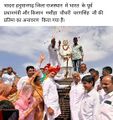


























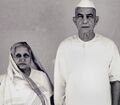



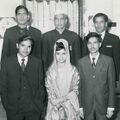


![Jai Pal Singh and his wife Vedvati, daughter of [[Charan Singh], 1959](/w/thumb.php?f=Jai_Pal_Singh_with_wife_Ved_Wati2.jpg&width=120)



































